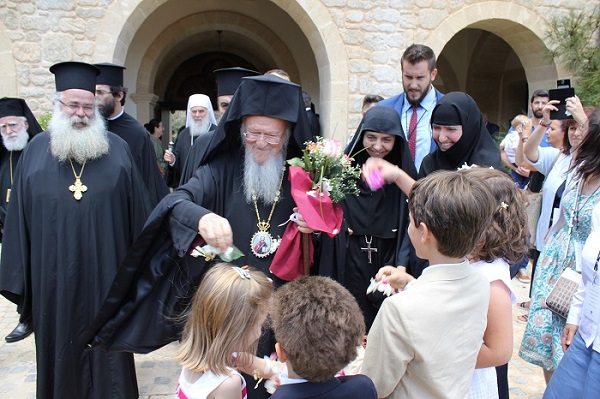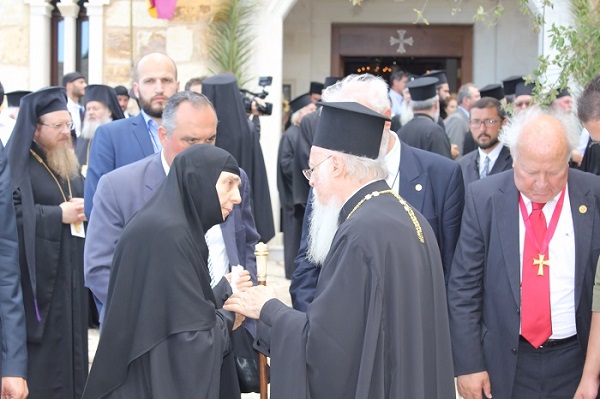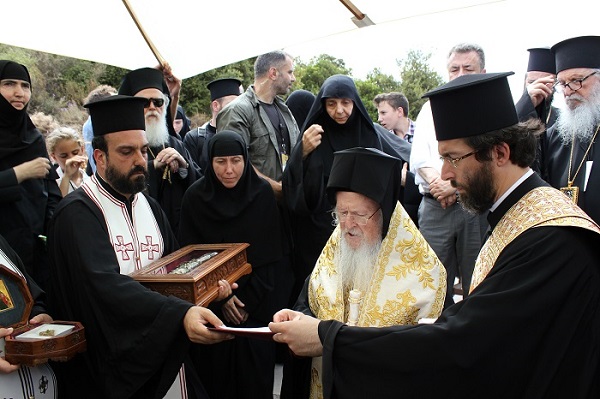Ecumenical Patriarch Bartholomew, the Abbess of Chrysopigi, and the Love of the Church
6 December 2018Two days following the Feast of St. Andrew the First-Called Apostle and the Patronal Feast of the Ecumenical Patriarchate of Constantinople, our Holy Metropolis is pleased to publish Ecumenical Patriarch Bartholomew, the Abbess of Chrysopigi, and the Love of the Church. This interview is timely, as well, because today our Holy Church celebrates the memory of St. Porphyrios Kafsokalyvitis who had a unique and special bond with the Holy Patriarchal and Stavropegic Monastery of Chrysopigi in Chania of Crete.
Mother Theoxeni is the Abbess of Chrysopigi. She first visited Canada and our Metropolis in March 2015 during Great Lent; with the blessing of His Eminence Metropolitan Sotirios, she delivered a keynote spiritual address on the life of St. Porphyrios. Mother Abbess Theoxeni also contributed a chapter in the recently published book sponsored by the Ecumenical Patriarchate Archons in Canada, Bartholomew in Canada: A Twenty Year Celebration, with the title: “Ecumenical Patriarch Bartholomew: The Abbot of the Great Church of Christ.” During a visit to Canada earlier this year, Mother Abbess Theoxeni was gracious to set some time aside to discuss the Monastery of Chrysopigi and its relationship with the Ecumenical Patriarchate and His All-Holiness Ecumenical Patriarch Bartholomew, among other topics of interest.

Ecumenical Patriarch Bartholomew greets a few of the many children at the Monastery of Chrysopigi, at Kastro.
Chrysopigi is a “Patriarchal and Stavropegic” Monastery; can you kindly explain to our readers what this distinction is and its relationship with the Phanar?
The institution of the patriarchal and stavropegic monastery is very ancient in the Church. From the ninth century, the Ecumenical Patriarchate began to make use of its special privilege to establish stavropegic monasteries in Metropolises under its jurisdiction. The word “Stavropegic” derives from the joining of “cross” and “to affirm” because historically a monastery was established as stavropegic when the foundation stone of the Katholikon, that is, the central church of a monastery, was completed with a cross by the patriarch or his representative. The monastery was officially sanctioned by a formal patriarchal seal, a document that secured the canonical rights of the Ecumenical Patriarchate. In patriarchal and stavropegic monasteries, the name of the ecumenical patriarch is commemorated.
There are many stavropegic monasteries in Greece and Cyprus, but also in Russia, Ukraine, Serbia, Romania, Bulgaria, Poland, and they continue to be founded in the world today.
Stavropegic monasteries and, more broadly, monasteries in general, served as a calm shelter during waves of invaders in different times and played an important role in shaping and safeguarding the consciousness of the Orthodox faithful throughout the course of history. They had an especially important role in Crete, during the period of long-suffering experienced under Venetian and Ottoman rule. The historical course of patriarchal and stavropegic monasteries affirms the unshakeable union between the Church of Crete and the Great Church of Christ onto the ages.
The Holy Monastery of the Lady of the Life-Giving Spring–Chrysopigi became stavropegic in the year 1654, while the relevant patriarchal seal (patriarchal letter) was issued in 1681. A renewal of its stavropegic status took place in 1706 with the seal of Patriarch Gabriel III, and again in 1797 with the seal of the Hieromartyr Gregory V.
The spiritual relationship between Chrysopigi and the Mother Church continues today. We commemorate daily in the Divine Liturgy the name of His All-Holiness Ecumenical Patriarch Bartholomew. His All-Holiness, during his visits to Crete, blessed our Monastery and the Sisterhood five times. In November 1992, during his first formal visit, the Sisterhood welcomed him led by Gerontissa Theosemni of blessed memory, who particularly respected the Ecumenical Patriarchate and with great zeal honoured the work and unifying actions of the Mother Church, together with her most respected primate. In June 2002, His All-Holiness visited Chrysopigi and performed a Trisagion [memorial service] for Gerontissa Theosemni of blessed memory (†2000); thereafter, he visited the new monastic settlement, which St. Porphyrios Kafsokalyvitis urged the Sisterhood to move to, and laid the foundation stone for our Katholikon, dedicated to the Transfiguration [Metamorphosis]. He also walked the stone-built pathways, blessed the monastic surroundings and prayed at the cave-chapels. In October 2009, he visited Chrysopigi, where a formal welcoming and doxology took place in the presence of thousands of faithful, and laid the foundation stone on a parcel of land that was donated by our Monastery to the institution “Daycare and Training Centre for Persons with Special Needs,” which services children and youth. On September 2, 2012, His All-Holiness presided over the dedication of the Transfiguration Katholikon; on the same day, he performed an Agiasmos [Blessing of the Waters] service at our Monastery’s Environmental Education Centre. On June 26, 2016, the Sunday of All Saints, at the conclusion of the Holy and Great Council, His All-Holiness blessed our Monastery, together with the other primates and members of the Council, and laid the foundation stone for the new parish dedicated to St. Porphyrios Kafsokalyvitis located on our Monastery grounds.
I understand that some Sisters from Chrysopigi also serve on a rotational basis at the Zoodochos Pigi (Lady of the Life-Giving Spring) Monastery at Baloukli in Constantinople. Can you speak to this point and the importance of diakonia (service) to the Ecumenical Patriarchate?
Each year, Sisters from our Monastery of Chrysopigi serve at Baloukli for approximately three months, consistent with the permitted stay with a visitor visa.
The Sisters at Baloukli, which is dedicated to the Lady of the Life-Giving Spring – as is our Monastery – adhere to the monastic program and fulfill their service responsibilities, as they do here at Chrysopigi. All of the church services are conducted each day; very often, pilgrims and visitors, including dignitaries, who visit Constantinople from around the world, make their way to the Monastery and participate in the Divine Liturgy that is conducted in the mornings, as well as the vespers service that takes place early in the evening.
Of course, other monastic sisterhoods also serve at Baloukli.
The presence of monastics at the historic Monastery of Baloukli, in Constantinople, is very important, because it allows for the continuation of the monastic tradition.
At the same time, we feel that we all owe a debt of service in response to the call of our Ecumenical Patriarch: “Visit us often! You should feel that your home is here. Let me impress upon you that the City [Constantinople] is not far from you. She is with you; she has you in her heart. Visit in order to experience the spiritual majesty and the nobility of Romiosini of Byzantium. If every one of your visits here will be joy and satisfaction and learning for you, for us, who bear the burden of history for so many centuries, it will be encouragement and a promise that you do not leave us alone without support”.

Ecumenical Patriarch Bartholomew and Abbess Theoxeni in the Monastery’s courtyard
This past June, as is often the case, you and a synod of Sisters made a pilgrimage to the Phanar to celebrate the Feast of the Holy Apostle Bartholomew and the Name Day of His All-Holiness. What are your observations and thoughts about the Ecumenical Patriarchate continuing its service of love and unity for global Orthodoxy today?
In Constantinople, for seventeen centuries now, beats the heart of Orthodoxy. The founder and protector of the Church of Constantinople is Saint Andrew the First-Called Apostle. The Ecumenical Patriarchate is based in the Phanar, the spiritual centre of the Orthodox Church, the timeless and ecumenical symbol of unity, who with goodwill has fought the good fight for the protection and dissemination of the Orthodox faith, just as it has received — unchanged and uncorrupted — from the apostolic times.
The primate of the Great Church of Christ, Ecumenical Patriarch Bartholomew, with his charismatic presence, his inspiring words, and his multifaceted actions for the unity of the One, Holy, Catholic, and Apostolic Church, the promotion of religious freedom and human rights, as well as for the protection of the natural environment, has been recognized as an international personality and dignitary with the highest global stature. With the highest degree of responsibility he bears the burden of the oecumene on his shoulders. With care he steers a course through the tragic moments of humanity and wrestles with the hard reality to protect the value and ideals of the Orthodox faithful, in order to preserve the unity of the Church, and to provide a global witness of love, peace, reconciliation and fraternity, as a guide towards the Kingdom of Heaven.
Continuing on this theme, the Ecumenical Patriarch, together with primates of the autocephalous Orthodox churches, visited Chrysopigi during the week of Pentecost and the Holy and Great Council that was held in Crete two years ago. In addition to being personally honoured by the Ecumenical Patriarchate to be an official delegate to the Council, the Monastery of Chrysopigi (Kastro), hosted a luncheon for hierarchs following the Synodal Divine Liturgy for the Sunday of All Saints. Can you share your experience of this historic and unique event in the life of the Church?
It was a great honour for me to participate in the Holy and Great Council. It gave me the unique opportunity to live and experience this spiritual event of the gathering of bishops from many different countries around the world.
The work of the Council was a spiritual labour, preceded each morning by the Divine Liturgy at the nearby monastery of Gonia. The Divine Liturgy was performed in different languages each day and presided over by the various local autocephalous churches who participated in the Council.
I confess that it is impossible for me to put into words the spiritual atmosphere, the expression of ethos by the Orthodox bishops, the expression of the highest responsibility, together with the fortitude and patience of the hundreds of hierarchs, who together through common worship and precise application of Orthodox theology expressed the consciousness and unity of the One, Holy, Catholic, and Apostolic Church.
The Holy Spirit was common and everywhere present in the Council. The primates, together with all of the participating hierarchs, expressed themselves with inspiring theological words, through the Council’s Chair, His All-Holiness Ecumenical Patriarch Bartholomew, who in general terms expressed the unity of the Council.
On the same day, Ecumenical Patriarch Bartholomew laid the foundation stone at Chrysopigi for the Church of St. Porphyrios Kafsokalyvitis, who is a modern-day saint and much beloved by the faithful. Can you talk about St. Porphyrios, including his relationship to Chrysopigi, as well as the Ecumenical Patriarchate and His All-Holiness, who presided over the Holy and Sacred Synod when St. Porphyrios (and St. Meletios of Ypseni in Rhodes) was entered in the registry of saints of the Orthodox Church in November 2013?
As referenced above, at the conclusion of the Holy and Great Council, that is, on the Sunday of All Saints (July 26, 2016), our Monastery had the unique blessing and honour to welcome the visit of the holy primates and their delegations of bishops. In the Katholikon of Metamorphosis [at Kastro] a doxology took place and subsequently a formal luncheon for all of the Council participants.
That same afternoon, His All-Holiness laid the foundation stone for the Church of St. Porphyrios at our Monastery, whose construction continues with traditional methods, including with stone from the local natural environment. Indeed, it must be mentioned that the construction of the parish was assisted and continues to be assisted by many individuals from Toronto, as well as from many cities of Canada and the United States, a fact which clearly shows the universal appeal of the Saint.
The spiritual relationship of our Monastery with St. Porphyrios is linked with the beginning of the settlement of Chrysopigi by Gerontissa Theosemni of blessed memory and the first two sisters of Chrysopigi, where the Saint had visited, blessing the new sisterhood together and guiding them on their way.

Ecumenical Patriarch Bartholomew lays the foundation stone for the Church of St. Porphyrios Kafsokalyvitis at the Holy Monastery of Chrysopigi.
The sisterhood of Chrysopigi was connected with St. Porphyrios with great reverence and respect, and developed a long distance spiritual relationship and communication with him. With his initiation and blessing did we begin constructing the new monastery of Metamorphosis, in the area of the caves where the Saint had directed us to by the grace of God. At the same time, St. Porphyrios encouraged the sisterhood to elevate the monastic life in the surrounding areas, to revive the ruined chapels and caves/hermitages nearby, as well as to protect the local habitat with the trees, birds, and natural springs.
The fatherly words of St. Porphyrios have been catalogued in the book “Wounded by Love: The Life and Wisdom of Saint Porphyrios,” which our Monastery has published. This book has been translated into more than twenty languages around the world and has been read by millions of people, transmitting to them words of comfort, hope, joy and the meaning of life and salvation.
St. Porphyrios valued and revered the person of Ecumenical Patriarch Bartholomew and referred to him always with respect, love, and confidence in the Mother Church. It is a very blessed coincidence that Ecumenical Patriarch Bartholomew had the great pleasure and honour to preside over the official proclamation of sainthood for St. Porphyrios during his patriarchal tenure.






